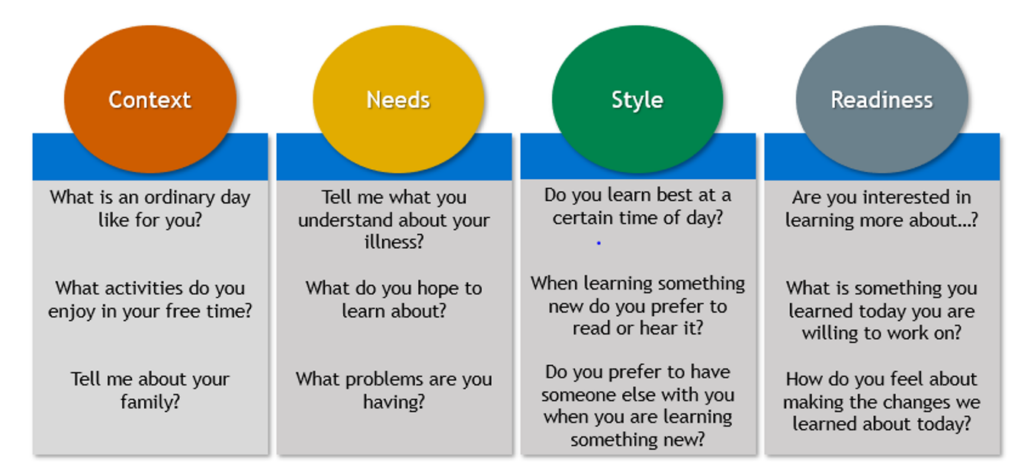
Patient Education Tools: Learning Needs Assessments – By understanding from a patient’s point of view what an ordinary day is like for them, what they enjoy doing, and how they best learn, health care professionals can better individualize their approach to improve patient outcomes and satisfaction. Providers can utilize assessments, like the one below, to draw out what brings value and importance to a patient’s life that provides context that is essential for behavior change. For example, if your goal is to get your patient to exercise more and you learn your patient adores their grandchildren, you can utilize that context as motivation to exercise more.

Learning needs assessments are fundamental to effective patient education. When these assessments are conducted, learning is more likely to lead to behavior change. Assessments include finding out what patients already know, what they want and need to learn, what they are capable of learning, and what would be the best way to teach them. Informal conversations are just as important as formal assessments when gauging learning needs; listen to your patients and become aware of their motivations and education needs.
Context
Start with finding out more about the patient and his or her life. Use open-ended questions that require the patient to reveal more details and listen carefully to their response. Ask them about what an ordinary day looks like for them, what activities they enjoy, and their relationships. Getting to know the patient on a personal level will lead to motivations and let you individually adapt your teaching.
Needs
Next, establish what the patient understands about their illness. Do they know the name of the diagnosis, the symptoms, and treatment plan? Providers do not need to re-teach something that the patient understands. When a patient describes their illness, it exposes the opportunity to assess if what they do know is accurate. To make sure your time with them is meaningful and valuable, ask patients what they hope to learn more about. If a patient has no intentions of changing their diet, for example, it’s a waste of time to educate them on diet. Considering these needs and tailoring your teaching strategy accordingly will ensure patient interactions are meaningful and valuable for both the provider and patient.
Style
Find how your patient learns best so you can match your teaching strategies to the patient’s learning style. Assess how patients learn best, when they learn best, and how they are able to the learn information. Do they prefer to have someone else with them when they’re learning something new? Do they learn best by hearing, reading, or touching? Good assessments of learning styles ensure optimal learning can occur.
Readiness
At the end of the discussion, gather information about the patient’s readiness to learn. Motivational interviewing can help providers determine the patient’s level of readiness to change and determine their motivations and fears behind that change. Patients who do not exhibit readiness to learn will find it hard to be receptive to any teaching. If willingness to learn is present, ask what patients are interested in learning more about and what’s something they learned about today that they’re going to work on. By tailoring the teaching session to topics that the patient is interested in, health care professionals can better individualize their approach to improve patient outcomes and satisfaction.
About the Author


